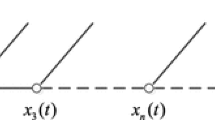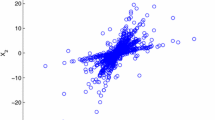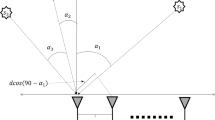Abstract
In this paper, blind source separation (BSS) techniques based on time–frequency (t–f) distributions are proposed for multi-sensor and mono-sensor scenarios. The proposed schemes use t–f filtering and high-resolution t–f distributions to extract source signals that have very close components in the t–f domain. Through numerical simulations, the performance of the proposed schemes is compared with the existing algorithms. Results show that the proposed method outperforms the traditional BSS methods. In addition, the proposed BSS is applied to detect a presence of a non-stationary signal in a scenario, when noise power is unknown. Detection performance is compared with the existing detection methods through numerical simulations that show the proposed method performs better than the existing methods.










Similar content being viewed by others
References
A. Aissa-El-Bey, N. Linh-Trung, K. Abed-Meraim, A. Belouchrani, Y. Grenier, Underdetermined blind separation of nondisjoint sources in the time–frequency domain. IEEE Trans. Signal Process. 55(3), 897–907 (2007)
A. Aissa-El-Bey, N. Linh-Trung, K. Abed-Meraim, A. Belouchrani, Y. Grenier, Underdetermined blind separation of nondisjoint sources in the time–frequency domain. IEEE Trans. Signal Process. 55(3), 897–907 (2007)
S. Ali, D. Ramírez, M. Jansson, G. Seco-Granados, J.A. López-Salcedo, Multi-antenna spectrum sensing by exploiting spatio-temporal correlation. EURASIP J. Adv. Signal Process. 2014(1), 1–16 (2014)
S. Ali, G. Seco-Granados, J.A. Lopez-Salcedo, Spectrum sensing with spatial signatures in the presence of noise uncertainty and shadowing. EURASIP J. Wirel. Commun. Netw. 2013(1), 1–16 (2013)
M.G. Amin, Y. Zhang, Direction finding based on spatial time–frequency distribution matrices. Digit. Signal Process. 10(4), 325–339 (2000)
A. Belouchrani, M.G. Amin, N. Thirion-Moreau, Y.D. Zhang, Source separation and localization using time–frequency distributions: an overview. IEEE Signal Process. Mag. 30(6), 97–107 (2013)
B. Boashash, G. Azemi, N.A. Khan, Principles of time–frequency feature extraction for change detection in non-stationary signals: applications to newborn EEG abnormality detection. Pattern Recognit. 48(3), 616–627 (2015)
B. Boashash, L. Boubchir, G. Azemi, A methodology for time–frequency image processing applied to the classification of non-stationary multichannel signals using instantaneous frequency descriptors with application to newborn EEG signals. EURASIP J. Adv. Signal Process. 2012(1), 1–16 (2012)
B. Boashash, N. Ali Khan, T. Ben-Jabeur, Time–frequency features for pattern recognition using high-resolution TFDs: a tutorial review. Digit. Signal Process. 40, 1–30 (2015)
G. Chabriel, M. Kleinsteuber, E. Moreau, H. Shen, P. Tichavsky, A. Yeredor, Joint matrices decompositions and blind source separation: a survey of methods, identification, and applications. IEEE Signal Process. Mag. 31(3), 34–43 (2014)
R. Chai, G. Naik, T.N. Nguyen, S. Ling, Y. Tran, A. Craig, H. Nguyen, Driver fatigue classification with independent component by entropy rate bound minimization analysis in an EEG-based system. IEEE J. Biomed. Health Inf. (2016). doi:10.1109/JBHI.2016.2532354
Y. Chi, Guaranteed blind sparse spikes deconvolution via lifting and convex optimization. IEEE J. Sel. Top. Signal Process. 10(4), 782–794 (2016)
P. Flandrin, Time–frequency filtering based on spectrogram zeros. IEEE Signal Process. Lett. 22(11), 2137–2141 (2015)
K. Ghartey, A. Papandreou-Suppappola, D. Cochran, Time-varying techniques for multisensor signal detection. IEEE Trans. Signal Process. 54(9), 3353–3362 (2006)
K. Ghribi, M. Djendi, D. Berkani, A wavelet-based forward bss algorithm for acoustic noise reduction and speech enhancement. Appl. Acoust. 105, 55–66 (2016)
L. Guo, Y.D. Zhang, Q. Wu, M.G. Amin, Doa estimation of sparsely sampled nonstationary signals, in IEEE China Summit and International Conference on Signal and Information Processing (ChinaSIP) (July 2015), pp. 300–304
Y. Guo, S. Huang, Y. Li, G.R. Naik, Edge effect elimination in single-mixture blind source separation. Circuits Syst. Signal Process. 32(5), 2317–2334 (2013)
Y. Guo, G.R. Naik, H. Nguyen, Single channel blind source separation based local mean decomposition for biomedical applications, in 35th Annual International Conference of the IEEE Engineering in Medicine and Biology Society (EMBC) (2013), pp. 6812–6815
P. Heidenreich, L.A. Cirillo, A.M. Zoubir, Morphological image processing for FM source detection and localization. Signal Process. 89(6), 1070–1080 (2009)
D.L. Jones, R.G. Baraniuk, An adaptive optimal-kernel time–frequency representation. IEEE Trans. Signal Process. 43(10), 2361–2371 (1995)
N.A. Khan, B. Boashash, Multi-component instantaneous frequency estimation using locally adaptive directional time frequency distributions. Int. J. Adapt. Control Signal Process. 30, 429–442 (2016)
N.A. Khan, I.A. Taj, M.N. Jaffri, S. Ijaz, Cross-term elimination in wigner distribution based on 2D signal processing techniques. Signal Process. 91(3), 590–599 (2011)
N.A. Khan, S. Ali, M. Jansson, Direction of arrival estimation using adaptive directional time–frequency distributions. Multidimens. Syst. Signal Process. (2016). doi:10.1007/s11045-016-0435-y
L. Le, S. Krishnan, Time–frequency signal synthesis and its application in multimedia watermark detection. EURASIP J. Adv. Signal Process. (1), 1–14 (2006)
Z. Li, X. Yan, Z. Tian, C. Yuan, Z. Peng, L. Li, Blind vibration component separation and nonlinear feature extraction applied to the nonstationary vibration signals for the gearbox multi-fault diagnosis. Measurement 46(1), 259–271 (2013)
N. Linh-Trung, A. Belouchrani, K. Abed-Meraim, B. Boashash, Separating more sources than sensors using time–frequency distributions. EURASIP J. Appl. Signal Process. 2005, 2828–2847 (2005)
S. Meignen, T. Oberlin, S. McLaughlin, Multicomponent signal denoising with synchrosqueezing, in 2012 IEEE Statistical Signal Processing Workshop (SSP) (2012), pp. 660–663
M. Mohammadi, A. Akbar Pouyan, N. Ali Khan, A highly adaptive directional time–frequency distribution. Signal Image Video Process. 10(7), 1369–1376 (2016)
M. Weifeng, M.G. Amin, Y. Zhang, Bilinear signal synthesis in array processing. IEEE Trans. Signal Process. 51(1), 90–100 (2003)
G.R. Naik, Enhancement of the ill-conditioned original recordings using novel ICA technique. Int. J. Electr. 99(7), 899–906 (2012)
G.R. Naik, K.G. Baker, H.T. Nguyen, Dependence independence measure for posterior and anterior EMG sensors used in simple and complex finger flexion movements: evaluation using SDICA. IEEE J. Biomed. Health Inf. 19(5), 1689–1696 (2015)
G.R. Naik, D.K. Kumar, Estimation of independent and dependent components of non-invasive EMG using fast ICA: validation in recognising complex gestures. Comput. Methods Biomech. Biomed. Eng. 14(12), 1105–1111 (2011)
G.R. Naik, S. Easter Selvan, H.T. Nguyen, Single-channel EMG classification with ensemble-empirical-mode-decomposition-based ICA for diagnosing neuromuscular disorders. IEEE Trans. Neural Syst. Rehabil. Eng. 24(7), 734–743 (2016)
G. Pendharkar, G.R. Naik, H.T. Nguyen, Using blind source separation on accelerometry data to analyze and distinguish the toe walking gait from normal gait in ITW children. Biomed. Signal Process. Control 13, 41–49 (2014)
L. Rankine, M. Mesbah, B. Boashash, IF estimation for multicomponent signals using image processing techniques in the time–frequency domain. Signal Process. 87(6), 1234–1250 (2007)
G. Rilling, P. Flandrin, P. Goncalves, On empirical mode decomposition and its algorithms, in IEEE-EURASIP Workshop on Nonlinear Signal and Image Processing, vol. 3, (2003), pp. 8–11
Z. Shan, J. Swary, S. Aviyente, Underdetermined source separation of EEG signals in the time–frequency domain, in IEEE International Conference on Acoustics, Speech and Signal Processing, 2008. ICASSP 2008 (March 2008), pp. 3637–3640
X. Sun, J. Wang, R. Chen, L. Kong, M.F.H. She, Directional Gaussian filter-based LBP descriptor for textural image classification. Procedia Eng. (CEIS) 15, 1771–1779 (2011)
H.L. Van Trees, Optimum Array Processing (Detection, Estimation, and Modulation Theory, Part IV) (Wiley-Interscience, New York, 2002)
A.V.D. Veen, Blind separation of BPSK sources with residual carriers. Signal Process. 73, 67–79 (1999)
A.V.D. Veen, S. Talwar, A. Paulraj, A subspace approach to blind space–time signal processing for wireless communication systems. IEEE Trans. Signal Process. 45, 173–190 (1997)
Y. Yang, X. Dong, Z. Peng, W. Zhang, G. Meng, Component extraction for non-stationary multi-component signal using parameterized de-chirping and band-pass filter. IEEE Signal Process. Lett. 22(9), 1373–1377 (2015)
Y.D. Zhang, M.G. Amin, B. Himed. Direction-of-arrival estimation of nonstationary signals exploiting signal characteristics, in 11th International Conference on Information Science, Signal Processing and their Applications (ISSPA) (2012), pp. 1223–1228
Y.D. Zhang, L. Guo, Q. Wu, M.G. Amin, Multi-sensor kernel design for time–frequency analysis of sparsely sampled nonstationary signals, in IEEE Radar Conference (RadarCon) (May 2015), pp. 0896–0900
Author information
Authors and Affiliations
Corresponding author
Rights and permissions
About this article
Cite this article
Ali, S., Khan, N.A., Haneef, M. et al. Blind Source Separation Schemes for Mono-sensor and Multi-sensor Systems with Application to Signal Detection. Circuits Syst Signal Process 36, 4615–4636 (2017). https://doi.org/10.1007/s00034-017-0533-6
Received:
Revised:
Accepted:
Published:
Issue Date:
DOI: https://doi.org/10.1007/s00034-017-0533-6




